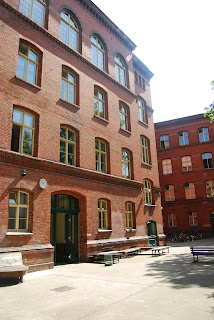
On my final full day in Berlin, we spent the morning at a factory known world-wide for its professional make-up products. This visit was included because it is an illustration of the school-to-work transition. We met briefly with a young woman who was completing a two year internship at the company, splitting her time between work and classes. The school/work model sounded promising, but given time constraints the young woman only spent a few minutes with the group, not enough time for more in-depth questions.
If the morning’s activities weren’t the highlight of this trip, the afternoon visit to a former Stasi(East German secret police) prison is an experience I will carry with me for a long time.Located in what was at one time the Berlin-Hohenschonhausen restricted area, the compound of drab brick buildings is still imposing and somber despite being out of use for over twenty years. The facility includes two former prisons, both used by Stasi for interrogation and extraction of information. The older of the prisons is subterranean and damp; entering the cell block our guided tour grew quiet. We visited 12 by 12 foot cells that at one time held eight or more prisoners; we learned of a woman sentenced to 25 years in prison for making a joke about Stalin, and another inmate who served 10 years for painting lipstick on a political leader’s statue.


Apart from feeling repulsed by stories and evidence of the level of cruelty and deprivation visited upon prisoners, I was stunned by the obsessive and paranoid detail the Stasi employed in capturing East German citizens and breaking their spirit. It is estimated that before the Stasi headquarters was overrun by outraged citizens in 1989, one of every 63 citizens of East Germany was a Stasi informant in some way, not to mention the nearly 100,000 Stasi officers. Our guide re-enacted some psychological tactics the Stasi used, several of us in the tour group sitting in positions within an interrogation room. The second prison on our tour had a one to one ratio between cells and interrogation rooms, the goal to have every prisoner under interrogation daily for up to eight hours.
Toward the end of the tour, we entered a long hallway with pale yellow linoleum flooring; the air was thick and acrid. “History is something you can read, see, touch, and also smell,” our guide said, referring to the lingering scent of chemical sanitizers used to clean floors while the prison was in operation. The museum operators have preserved the authenticity of the former prison by not replacing the flooring. Of course it would have been easier to scrub away some of these memories, but important lessons of the past would have been lost in the process.
I could go on and on about how oppressive the former Stasi were, how this facility still embodies their cruelty, about how incomprehensible it seems to me that civil society in East Berlin didn’t know about this facility in their midst (then again, I have never lived under such a regime and can't claim any credibility in my conclusion), about the foreboding architecture of this area of the city. While some of this may be true, there are always multiple perspectives, a fact I have appreciated not only about this visit to the prison but other experiences during my time in Berlin. It was courageous for the Checkpoint Charlie foundation to include this as well as the Otto Weidt museum on our itinerary; they could have substituted with other less emotional or controversial outings, but what lessons would we have missed?
Due to a slow connection, I am currently having challenges uploading photos. I will insert these as soon as possible.














































